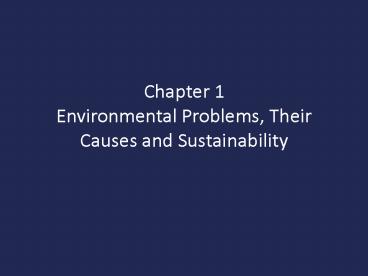Chapter 1 Environmental Problems, Their Causes and Sustainability - PowerPoint PPT Presentation
1 / 25
Title:
Chapter 1 Environmental Problems, Their Causes and Sustainability
Description:
We depend on it for survival. ... Amount of biologically productive land and water needed to provide an indefinite supply of renewable resources and to absorb and ... – PowerPoint PPT presentation
Number of Views:171
Avg rating:3.0/5.0
Title: Chapter 1 Environmental Problems, Their Causes and Sustainability
1
Chapter 1Environmental Problems, Their Causes
and Sustainability
2
Environmental Science vs. Environmentalism
- Environmental Science is an interdisciplinary
study - Environmentalism is a philosophy and social
movement dedicating to protecting the earth and
environmental conservation
3
What is the environment and why study it?
- Everything around us living and nonliving
- We depend on it for survival
- Environmental science is an interdisciplinary
study of how humans interact with their
surroundings - Ecology is big component
4
Sustainability
- The capacity of the earths natural systems and
human cultural systems to survive, flourish and
adapt to changing environmental conditions into
the very long-term future - Earth has been sustained for 4.5 billion years
- Life on earth 3 billion years
5
How has life on Earth sustained itself?
- Three Principles of Sustainability
- Reliance on sun (photosynthesis, warms earth,
atmospheric and oceanic circulation) - Biodiversity - variety of organisms providing
food, shelter, renewal of topsoil, pest control,
air purification, fertilization, etc.) - Nutrient Cycling circulation of carbon,
nitrogen and others from soil, water and
organisms
6
Natural Capital
- Natural resources and natural services that keep
us and other forms of life alive and support our
human economies
7
- Natural Capital Natural Resources Natural
Services - Resources materials and energy that are useful
or essential to humans air, water, soil, wind,
solar energy, etc. - Services processes in nature that support life
air purification, renewal of topsoil
8
Resources
- Perpetual- continuous supply sun, wind
- Renewable dont use it faster than nature can
renew it forests, grasslands, fish populations,
fresh water, etc. - Nonrenewable exist in a fixed amount can be
renewed but takes a long time fossil fuels,
metals, etc.
9
We are living unsustainably
- Environmental Degradation we are wasting,
degrading and depleting the earths natural
capital at an accelerating rate - Examples?
- Forests shrinking
- Soil eroding
- Glaciers melting
- Sea level rising
- Rivers drying
- Coral reefs disappearing
- Biodiversity decreasing
10
(No Transcript)
11
Pollution What is it? Examples?
12
Pollution
- Presence of a substance, heat, noise that is
harmful to the health or survival of humans or
other organisms
13
Point vs. Nonpoint Source Pollution
14
Activity marine debris timeline
15
Types of Property
- Private property individuals or companies own
the rights to land, minerals or other resources - Common property rights to certain resources are
held by large groups of individuals (ex National
parks) - Open access renewable resources atmosphere,
underground water supplies, open ocean
16
- Many common property and open access renewable
resources have been degraded. - Biologist Garrett Hardin (1968) called this the
- Tragedy of the Commons
- If I dont use this resource, someone else will.
The little bit that I use or pollute is not
enough to matter and anyway, its a renewable
resource. - Okay until the number of users gets too big. So
whats the answer?
17
http//www.pbs.org/wgbh/nova/worldbalance/material
.html
18
Ecological Footprint
- Amount of biologically productive land and water
needed to provide an indefinite supply of
renewable resources and to absorb and recycle the
wastes and pollution produced by such resource use
19
If ecological footprint is greater than
biological capacity (biocapacity) there is an
ecological deficit.
20
Homework www.myfootprint.org estimate your
own ecological footprint
21
Read p 21-22. Which has more harmful
environmental effects, affluence or poverty?
Explain
22
Environmental Sustainability
- Living off the earths natural income without
depleting or degrading the natural capital that
supplies them. - Natural income renewable resources (plants,
animals, soil) - Considerable evidence that were living
unsustainably (remember your ecological
footprint?)
23
- How do we globally live sustainably?
- What are the challenges we face in trying to do
so? - Can a few make a difference?
24
Never doubt that a small group of thoughtful,
committed citizens can change the world. Indeed,
it is the only thing that ever has. Margaret
Mead, anthropologist
25
- 50-100 years to make a shift in living
unsustainably to living sustainably. - Three principles of sustainability (general
themes in this class) - Rely on renewable energy from the sun, wind,
water - Protect biodiversity
- Reduce production of waste and pollution as to
not degrade nature































